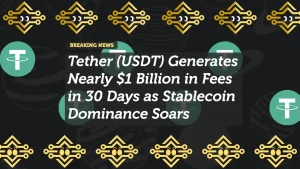
Tether CEO Projects $15 Billion Profit for 2025 With 99% Profit Margin
Tether, the world’s largest stablecoin issuer, is on track to record a staggering $15 billion in profit this year, according to CEO Paolo Ardoino. Speaking at a recent industry event, Ardoino highlighted that Tether’s operations are now running at an astonishing 99% profit margin, fueled by surging demand for USDT and record earnings from U.S. Treasury holdings.
How Tether Generates Billions in Profit
Tether’s profitability boom comes primarily from its massive reserves of U.S. Treasuries and cash-equivalent assets, which generate substantial interest income as global rates remain elevated. With over $120 billion USDT in circulation, Tether’s reserve portfolio makes it one of the largest holders of short-term government debt worldwide — comparable to mid-sized national central banks.
“Tether is not just a stablecoin company; it’s a liquidity powerhouse,” Ardoino stated. “Our efficiency and scale allow us to operate with near-total margins while maintaining full transparency and stability for users.”
99% Profit Margin — What It Really Means
A 99% profit margin implies that Tether’s operational costs are negligible relative to its interest income. The company employs a lean operational structure and relies on automated reserve management systems, which help minimize overhead.
However, such margins have also reignited debate within the crypto community over whether Tether’s dominance could pose systemic risks to the broader digital asset economy.
Transparency, Reserves, and Regulatory Spotlight
Tether has faced longstanding questions about the composition and transparency of its reserves, though recent attestation reports and blockchain-based disclosures have eased some investor concerns. Ardoino reiterated that all Tether tokens are fully backed and that the firm continues to enhance public audits and real-time proof-of-reserves initiatives.
The company’s growing profits may also invite regulatory attention, as governments and financial watchdogs around the world push for stablecoin legislation to ensure compliance and systemic stability.
Tether’s Expanding Footprint
Beyond its flagship USDT token, Tether has been expanding aggressively into new sectors:
- Bitcoin mining operations in Latin America
- AI and renewable-energy investments
- Development of a peer-to-peer financial infrastructure in emerging markets
These moves suggest that Tether aims to diversify its income streams and solidify its role as a key infrastructure player in the digital-asset economy.
Market Impact and the Road Ahead
The forecasted $15 billion profit underscores how stablecoins have evolved into a core pillar of the global crypto economy. Tether’s revenue strength gives it enormous leverage to reinvest in technology, infrastructure, and ecosystem stability — while simultaneously reinforcing its market dominance over rivals such as Circle’s USDC and PayPal USD.
Still, analysts warn that as Tether’s balance sheet swells, scrutiny from regulators and traditional finance will intensify, particularly if stablecoins continue to outpace regional bank deposit growth.
Conclusion
Tether’s projected $15 billion profit with a 99% margin signals a new era of financial power for stablecoin issuers. As interest income, adoption, and institutional usage soar, Tether remains the undisputed heavyweight of the crypto liquidity arena — but with that power comes the responsibility of maintaining unshakable transparency and trust in an increasingly regulated global market.














